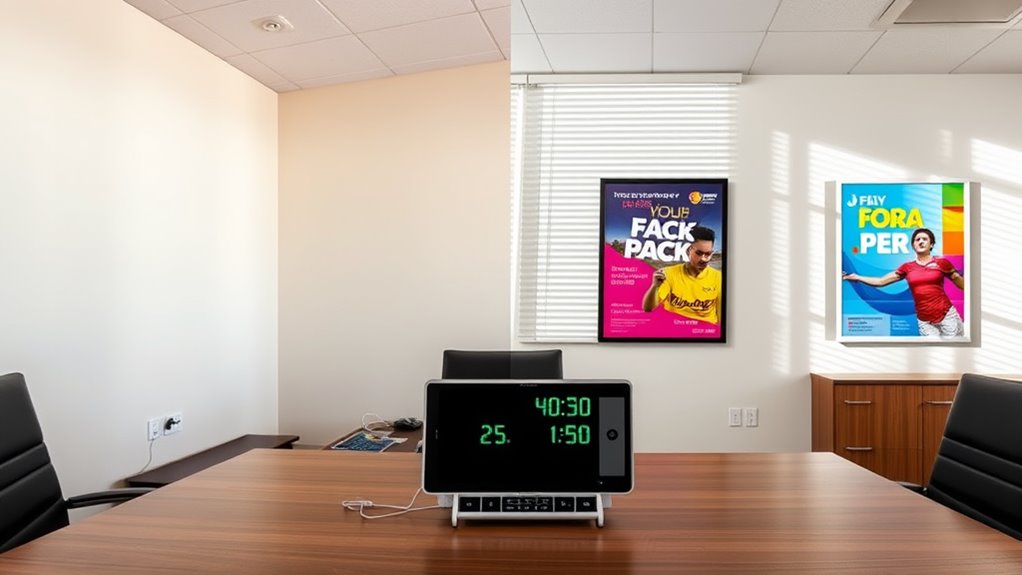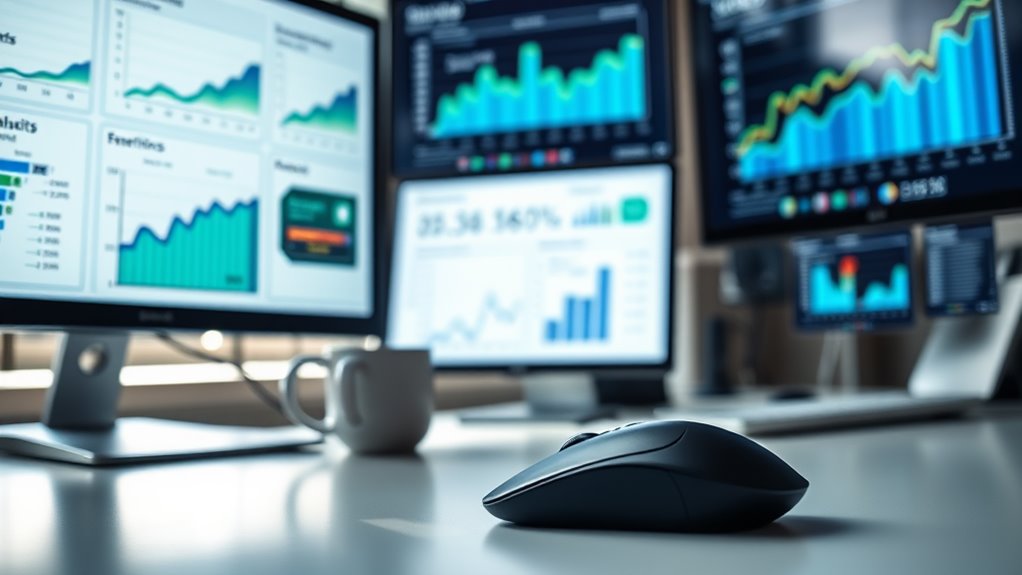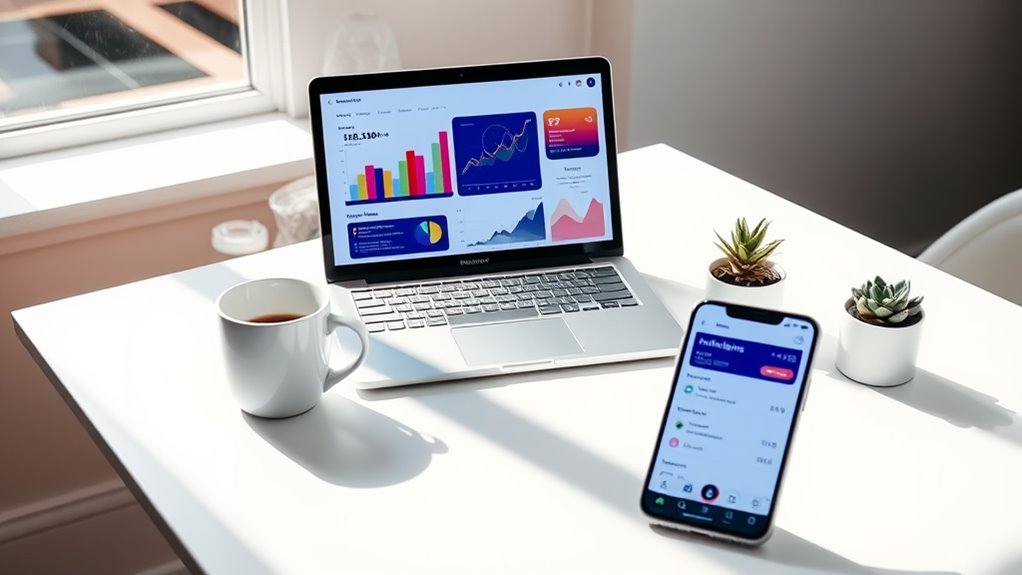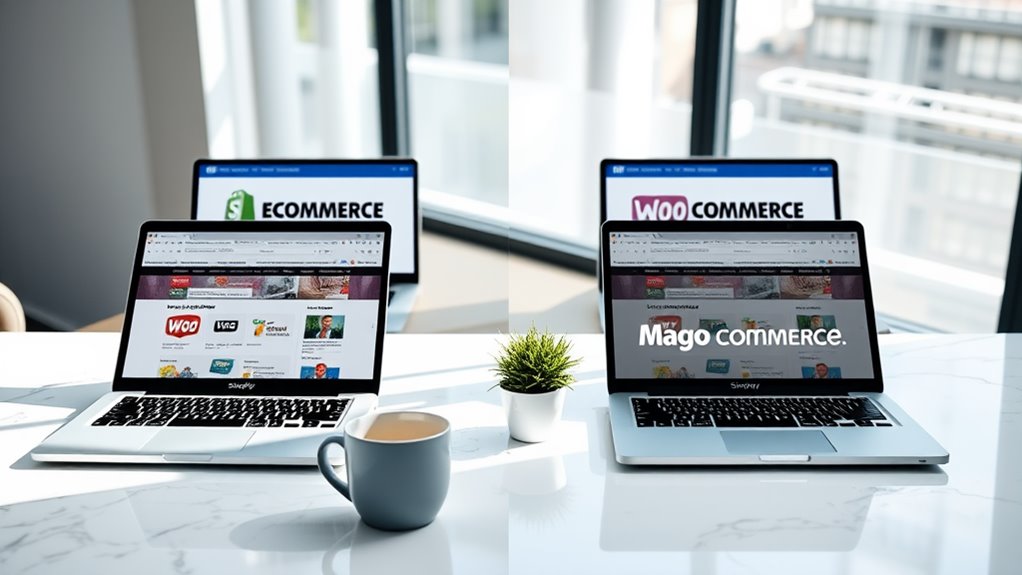Posters can be highly cost-effective when you implement them strategically. With production costs ranging from $0.50-15 per square foot depending on printing method, you'll find the initial investment relatively modest compared to other advertising channels. You can achieve ROI ratios between 3:1 and 6:1, especially when ordering in bulk quantities of 100+ units, which reduces per-unit costs by 30-40%. Digital alternatives might cost $2,000-5,000 initially, while print posters typically run $50-200 each and last 3-6 months. Your success depends on location selection, design quality, and target audience alignment—factors that drive long-term brand visibility and customer engagement.
Key Takeaway
- Volume ordering of 100+ posters can reduce per-unit costs by 30-40%, making them highly cost-effective for large campaigns.
- Posters maintain effectiveness for months without additional costs, providing continuous brand exposure in high-traffic areas.
- Cost-per-impression metrics are favorable as posters generate repeated viewership, with 68% of consumers recalling regularly seen posters.
- Print posters cost $50-200 each with 3-6 month lifespan, compared to digital alternatives requiring $2,000-5,000 initial investment.
- Industry benchmarks show ROI ratios of 3:1 to 6:1, indicating strong cost effectiveness when strategically placed.
Understanding Poster Production Costs
While many businesses overlook the hidden expenses, poster production costs depend on several key factors: printing method, size, quantity, paper quality, and design complexity.
Key Cost Components You'll Need to Take into Account:
- Printing Methods
- Digital printing: $2-5 per square foot for small runs
- Offset printing: $0.50-2 per square foot for large quantities
- Screen printing: $5-15 per square foot for specialty finishes
- Paper Selection
- Standard bond: $0.30-0.60 per square foot
- Photo-quality: $0.75-1.50 per square foot
- Premium cardstock: $1-2 per square foot
You'll find that volume greatly impacts your per-unit costs. When you're ordering 100+ posters, you'll typically see a 30-40% reduction in price compared to small-batch orders.
Design costs can range from:
- Basic template modification: $50-150
- Custom design work: $200-500
- Complex artistic creation: $500-1,500
Remember to factor in additional expenses like:
- Color calibration fees
- Proof copies
- Shipping and handling
- Rush order premiums
- Storage costs for bulk orders
These components will help you calculate your true cost per poster and determine ideal order quantities.
Return on Investment Analysis
Now that you understand the production costs involved, measuring your poster campaign's return on investment (ROI) becomes the next logical step. You'll need to track specific metrics to determine if your investment is generating worthwhile returns.
Key ROI Metrics to Monitor:
- Customer acquisition cost (total campaign cost ÷ new customers gained)
- Conversion rate (number of responses ÷ total viewer impressions)
- Revenue generated from poster-driven sales
- Brand awareness increase (measured through surveys)
Calculating Your ROI:
- Track direct responses using unique QR codes or promo codes
- Monitor foot traffic increases during campaign periods
- Compare sales data before and after poster placement
- Document social media mentions related to your posters
Industry benchmarks suggest successful poster campaigns typically achieve:
- 2-5% response rate in high-traffic areas
- ROI ratios between 3:1 and 6:1
- Brand recall improvements of 15-25%
You'll want to analyze these metrics over at least a 3-month period to get accurate results. Remember to factor in seasonal variations and competing marketing efforts when evaluating your poster campaign's effectiveness. Regular monitoring allows you to optimize placement and design for maximum returns.
Location Impact on Effectiveness
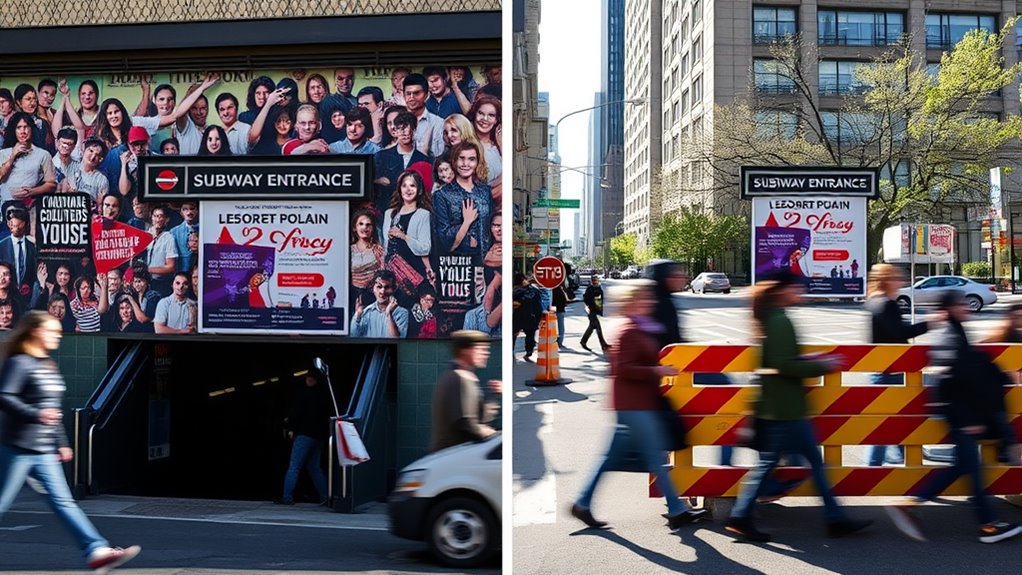
Regarding poster advertising, location selection can make or break your campaign's success. You'll need to carefully analyze foot traffic patterns and viewer demographics to maximize your poster's impact.
Key Location Factors to Evaluate:
- Visibility distance: Your poster should be readable from at least 20-30 feet away
- Lighting conditions: Natural and artificial lighting affects viewability by up to 40%
- Competition: Areas with fewer competing advertisements can increase attention by 25%
- Dwell time: Locations where people wait or pause naturally increase engagement
High-Impact Placement Options:
- Transit hubs: Train stations and bus stops offer 4-7 minutes of average viewing time
- Shopping centers: Mall corridors typically generate 15,000+ daily impressions
- Office buildings: Elevator areas provide captive audience opportunities
- University campuses: Strategic placement can reach 85% of student population
You'll want to conduct location audits before finalizing placement decisions. Research shows that properly placed posters in high-traffic areas can generate up to 3x more engagement than poorly positioned alternatives. Remember to factor in seasonal changes, as weather conditions and daylight hours will affect your poster's visibility throughout the year.
Digital Vs Print Advertising
Businesses face a critical choice between digital and print poster advertising in today's mixed-media landscape. You'll need to evaluate how each format serves your specific marketing goals and budget constraints.
Digital Advantages:
- You can update content instantly and schedule multiple designs
- Analytics let you track viewer engagement and demographics
- Lower long-term costs with no printing or installation fees
- Interactive elements like QR codes enhance engagement
Print Benefits:
- You'll maintain visibility even during power outages or technical issues
- Your message reaches audiences experiencing digital fatigue
- Physical presence creates lasting brand impressions
- No dependency on viewer's device capabilities
Cost Comparison:
- Digital: $2,000-5,000 initial hardware investment, plus $20-50 monthly content management
- Print: $50-200 per poster, with replacement costs every 3-6 months
Your ideal strategy might combine both formats. You could use digital displays in high-traffic indoor locations where power and connectivity are reliable, while placing weather-resistant print posters in outdoor spaces. Remember that your target audience's preferences should guide your choice – younger demographics typically respond better to digital, while traditional print still resonates strongly across age groups.
Design Elements and Visibility
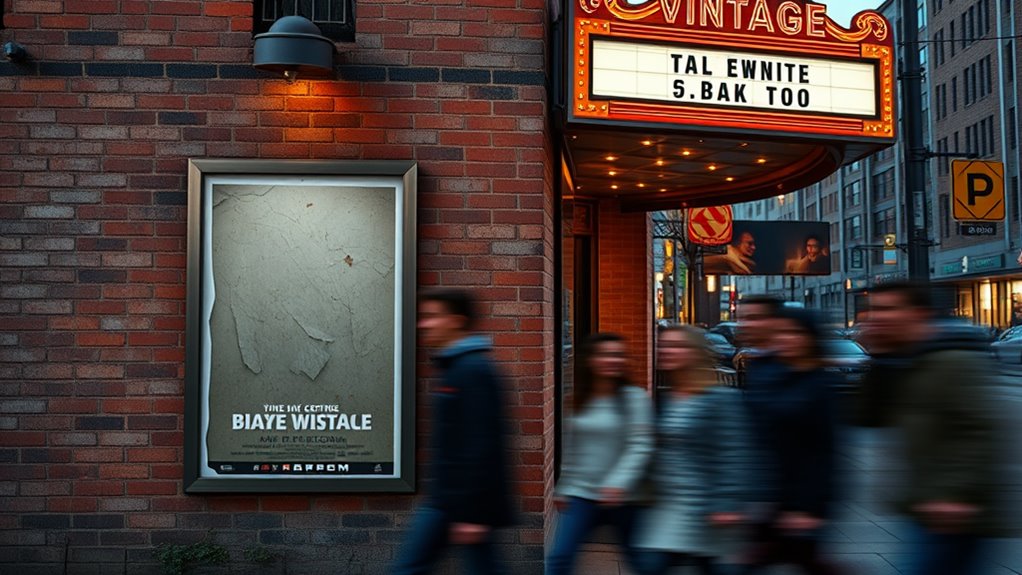
The essential design elements of your poster campaign directly impact its visibility and effectiveness. When you're designing for maximum impact, you'll need to take into account contrast, typography, spacing, and visual hierarchy to guarantee your message cuts through the noise.
Key design elements that'll boost your poster's visibility include:
- High contrast color combinations that maintain 70% readability from 20 feet away
- Font sizes scaling from 72pt for headlines to 24pt for body text
- Strategic white space allocation comprising 30-40% of the design
- Clear call-to-action placement in the bottom third of the layout
You'll want to incorporate eye-tracking patterns into your design strategy, as studies show viewers typically scan posters in a Z-pattern for about 2-3 seconds. Position your most vital information along these natural sight lines to maximize retention.
Take into account environmental factors when planning your poster's visibility. You'll need weather-resistant materials for outdoor displays, and anti-glare finishes for areas with direct lighting. Additionally, you should test your designs in various lighting conditions to guarantee they remain effective throughout the day.
Target Audience Engagement Metrics
Measuring your target audience's engagement with poster campaigns requires specific metrics and tracking methods. You'll need to establish clear KPIs to evaluate your poster's performance and ROI effectively.
Key Engagement Metrics to Track:
- Foot traffic patterns near poster locations (using sensors or manual counting)
- QR code scans or custom URL visits from poster calls-to-action
- Social media mentions and hashtag usage related to your campaign
- Sales lift in geographic areas where posters are displayed
- Brand recall surveys among target demographic
Performance Measurement Tools:
- Heatmap tracking for high-traffic poster locations
- Mobile device proximity data
- Customer feedback through digital touchpoints
- A/B testing of different poster designs and placements
You'll want to establish baseline metrics before launching your campaign and track changes over time. For example, if you're using QR codes, you can expect a 15-25% engagement rate in high-traffic areas. Remember to cross-reference your poster campaign's performance with other marketing channels to determine true cost-effectiveness and attribution.
Consider implementing:
- Weekly engagement reports
- Geographic response tracking
- Demographic interaction analysis
- Cost-per-impression calculations
Long-Term Marketing Value
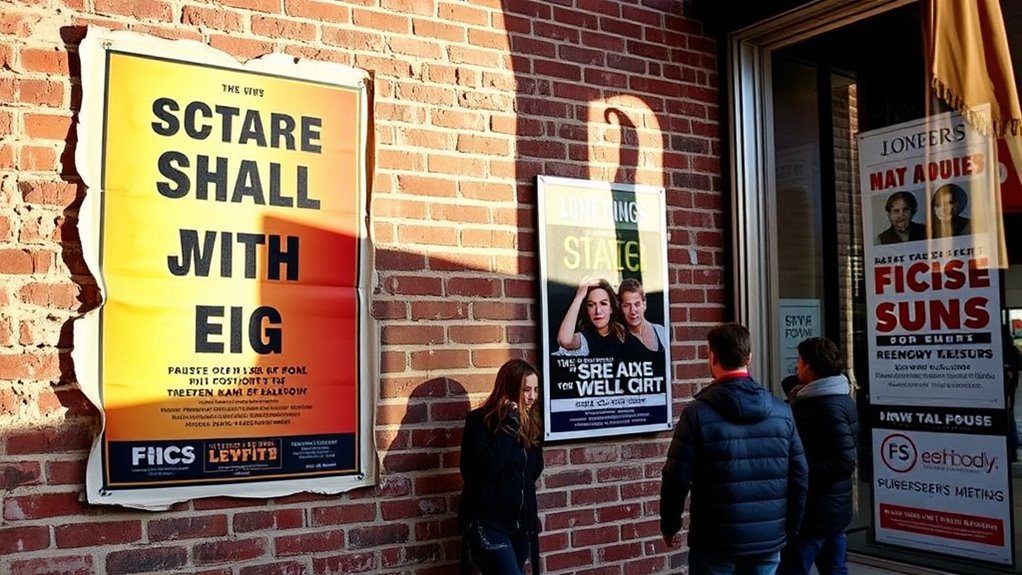
Investing in poster campaigns creates enduring marketing value that extends far beyond initial impressions. Your marketing dollars maintain influence through repeated viewership and brand recognition that builds over time, making posters a sustainable advertising investment.
Key Long-Term Benefits:
- Your posters can remain effective for months or years, continuing to generate impressions at no additional cost
- You'll establish location-based brand recognition, with 68% of consumers reporting they remember posters they see regularly
- Your design assets can be repurposed across multiple campaigns and platforms, maximizing ROI
- You're building a physical presence that competitors can't easily disrupt or replace
When you strategically place posters in high-traffic areas, they become part of the environmental landscape, contributing to your brand's permanent visibility. You'll find that well-designed posters often get photographed and shared on social media, extending their reach organically. The durability of modern printing materials means your investment stays visually appealing longer, while digital integration through QR codes keeps your message current and trackable. Consider implementing a rotating poster strategy to maintain freshness while leveraging established placement relationships.
Conclusion
Your investment in posters can be highly cost-effective when you've carefully considered placement, design, and target audience. You'll maximize returns by choosing high-traffic locations, incorporating eye-catching visuals, and maintaining consistent branding. While digital alternatives exist, well-executed print posters deliver tangible presence, local impact, and lasting impressions. Whether you're promoting events, products, or services, posters remain a practical, budget-friendly marketing tool that connects with audiences where they live, work, and shop.

